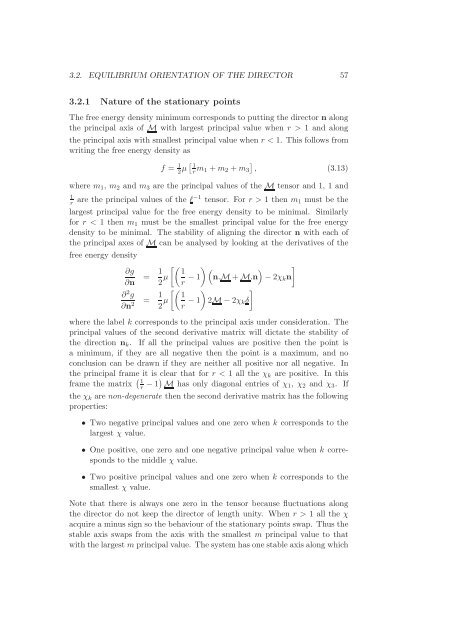Statistical models of elasticity in main chain and smectic liquid ...
Statistical models of elasticity in main chain and smectic liquid ...
Statistical models of elasticity in main chain and smectic liquid ...
Create successful ePaper yourself
Turn your PDF publications into a flip-book with our unique Google optimized e-Paper software.
3.2. EQUILIBRIUM ORIENTATION OF THE DIRECTOR 573.2.1 Nature <strong>of</strong> the stationary po<strong>in</strong>tsThe free energy density m<strong>in</strong>imum corresponds to putt<strong>in</strong>g the director n alongthe pr<strong>in</strong>cipal axis <strong>of</strong> M with largest pr<strong>in</strong>cipal value when r > 1 <strong>and</strong> alongthe pr<strong>in</strong>cipal axis with smallest pr<strong>in</strong>cipal value when r < 1. This follows fromwrit<strong>in</strong>g the free energy density asf = 1 2 µ[ 1r m 1 +m 2 +m 3], (3.13)where m 1 , m 2 <strong>and</strong> m 3 are the pr<strong>in</strong>cipal values <strong>of</strong> the M tensor <strong>and</strong> 1, 1 <strong>and</strong>1r are the pr<strong>in</strong>cipal values <strong>of</strong> the l−1 tensor. For r > 1 then m 1 must be thelargest pr<strong>in</strong>cipal value for the free energy density to be m<strong>in</strong>imal. Similarlyfor r < 1 then m 1 must be the smallest pr<strong>in</strong>cipal value for the free energydensity to be m<strong>in</strong>imal. The stability <strong>of</strong> align<strong>in</strong>g the director n with each <strong>of</strong>the pr<strong>in</strong>cipal axes <strong>of</strong> M can be analysed by look<strong>in</strong>g at the derivatives <strong>of</strong> thefree energy density∂g∂n = 1 [( ) 1 ( )2 µ r −1 n.M+M.n∂ 2 g∂n 2 = 1 [( ) ] 12 µ r −1 2M−2χ k δ]−2χ k nwhere the label k corresponds to the pr<strong>in</strong>cipal axis under consideration. Thepr<strong>in</strong>cipal values <strong>of</strong> the second derivative matrix will dictate the stability <strong>of</strong>the direction n k . If all the pr<strong>in</strong>cipal values are positive then the po<strong>in</strong>t isa m<strong>in</strong>imum, if they are all negative then the po<strong>in</strong>t is a maximum, <strong>and</strong> noconclusion can be drawn if they are neither all positive nor all negative. Inthe pr<strong>in</strong>cipal frame it is clear that for r < 1 all the χ k are positive. In thisframe the matrix ( 1r −1) M has only diagonal entries <strong>of</strong> χ 1 , χ 2 <strong>and</strong> χ 3 . Ifthe χ k are non-degenerate then the second derivative matrix has the follow<strong>in</strong>gproperties:• Two negative pr<strong>in</strong>cipal values <strong>and</strong> one zero when k corresponds to thelargest χ value.• One positive, one zero <strong>and</strong> one negative pr<strong>in</strong>cipal value when k correspondsto the middle χ value.• Two positive pr<strong>in</strong>cipal values <strong>and</strong> one zero when k corresponds to thesmallest χ value.Note that there is always one zero <strong>in</strong> the tensor because fluctuations alongthe director do not keep the director <strong>of</strong> length unity. When r > 1 all the χacquire a m<strong>in</strong>us sign so the behaviour <strong>of</strong> the stationary po<strong>in</strong>ts swap. Thus thestable axis swaps from the axis with the smallest m pr<strong>in</strong>cipal value to thatwiththe largest m pr<strong>in</strong>cipal value. Thesystem has onestable axis along which
















